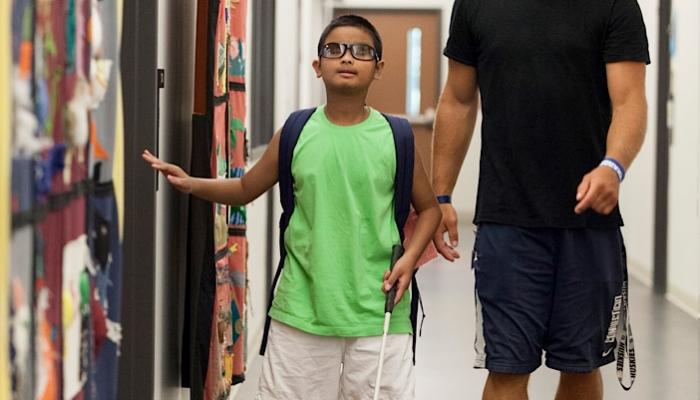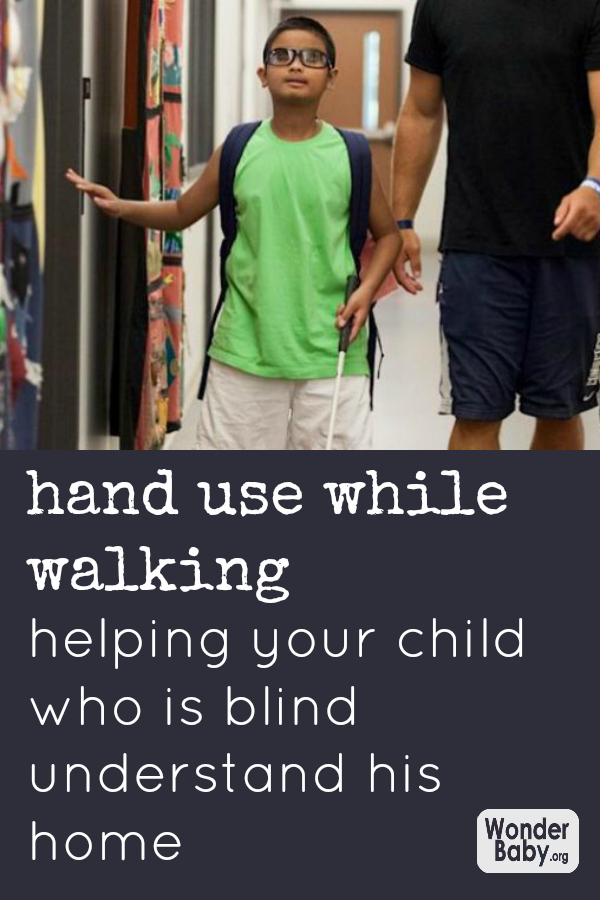Hand Use While Walking: Helping Your Child Who is Blind Understand His Home

Encourage your child to touch the closest wall, cabinet, or piece of furniture as she walks independently or holding your hand. Probably, the best areas for this are the hallway, kitchen and any time she moves from one room to another. This intermittent touching will help prepare for the brief trailing she will need to use to find specific doorways (bathroom, parent’s room, classroom) when consistently walking by herself.
Remind your child to put her “hands out in front” when she’s approaching any obstacle. She should be able hold out her hands for the last two feet before contacting the obstacle, but not for much further than that… for young children holding their hands out for very long may require more upper body strength than they have.
Continue to encourage your child to move independently and use her hands during common daily routines, such as:
- Finding a toy in her room.
- Getting her shoes to go outside or to the store.
- Getting her Sippy Cup from the fridge (with help).
- Touch-trail to the bathtub for her bath.
- Come to her high chair for meals and snack time.
Help her do this by going to the destination (high chair, bathtub, toy corner in the bedroom, etc) and calling her to come there AND providing a sound (jiggle the high chair to make a familiar squeaking sound, run water in the tub, make a sound with a familiar toy, etc).
Involve your child, at least briefly, in a variety of simple household tasks. These experiences help increase her understanding of her world and lead to improved language, independence and reasons to move and explore. Try keeping a list of the common events she’s experienced. Repeat the ones she seems to enjoy and try new ones often. Try helping her:
- Get Daddy a cup of water from the sink.
- Put 2 or 3 grocery items in the fridge.
- Warm oatmeal in the microwave.
- Put clothes in the washer and start the machine.
- Put her clean clothes in her dresser drawer.
- Put away 2 to 3 toys each day.
- Stir instant pudding, make a sandwich, pour cereal out of the box, get her crackers or cookies out of the box or bag.
- Peel fruit and put on a plate.
- Put 2 dishes in the dishwasher.
- Wash cups in the sink.
- Take dirty dishes to the counter or sink.
Let her use push toys as anticipators inside the house, but don’t insist. When she seems to want to use it stay right with her to tell her what she contacts with the push toy: the sofa, the wall, a toy on the floor, etc. Tell her what it is and show her how to “turn it” away from the obstacle and keep walking. Try showing her how she can carry favorite items from room to room, perhaps to take something special to Mommy or put a toy back where it belongs.
Read this article in Spanish: Lea este articulo en Español
Read this article in Arabic: قراءة هذا المقال بالعربية
Read this article in Dutch: Lees dit artikel in het Nederlands

Related Posts

Eye Conditions and Syndromes, Visual Impairment
Neuralink Announces Plans to Restore Sight to the Blind with Brain Chip
Elon Musk’s company Neuralink has announced plans to begin human trials of its new “Blindsight” brain chip by the end of 2025.

Visual Impairment
The Gift of Understanding: How a Young Child Helps His Blind Father Navigate Life
When a parent is blind, it’s natural for people to wonder how their sighted child will adapt. Will they struggle to understand their parent’s needs? Will they feel burdened by...

Braille and Literacy, Toys, Visual Impairment
24 Braille Toys for Kids Who are Blind
Everything from alphabet blocks to raised line coloring pages and activity books to puzzles to card and board games... and so much more! And it's all in braille ready for...